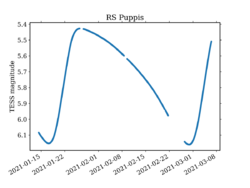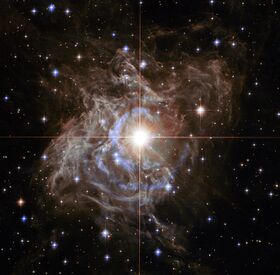Astronomy:RS Puppis
| Observation data Equinox J2000.0]] (ICRS) | |
|---|---|
| Constellation | Puppis |
| Right ascension | 08h 13m 04.21601s[1] |
| Declination | −34° 34′ 42.7023″[1] |
| Apparent magnitude (V) | 6.5-7.6[2] |
| Characteristics | |
| Spectral type | G2Ib[3] (F9 - G7[4]) |
| U−B color index | 1.2[5] |
| B−V color index | 1.5[5] |
| Variable type | δ Cep[4] |
| Astrometry | |
| Radial velocity (Rv) | 24.60[6] km/s |
| Proper motion (μ) | RA: -3.19[1] mas/yr Dec.: 2.33[1] mas/yr |
| Parallax (π) | 0.5844 ± 0.0260[7] mas |
| Distance | 5,600 ± 200 ly (1,710 ± 80 pc) |
| Absolute magnitude (MV) | -5.70[8] |
| Details | |
| Mass | 9.2[8] M☉ |
| Radius | 191[9] (164 - 208) R☉ |
| Luminosity | 21,700[9] (14,200 - 29,500) L☉ |
| Temperature | 5,060[9] (4,640 - 5,850) K |
| Metallicity [Fe/H] | 0.17[10] dex |
| Age | 28[10] Myr |
| Other designations | |
HD 68860, HIP 40233, SAO 198944, CD−34°4488 | |
| Database references | |
| SIMBAD | data |
RS Puppis (or RS Pup) is a Cepheid variable star around 6,000 ly away in the constellation of Puppis. It is one of the biggest and brightest known Cepheids in the Milky Way galaxy and has one of the longest periods for this class of star at 41.5 days.
Distance
The distance to RS Puppis is important because Cepheids serve as a marker for distances within the Milky Way galaxy and for nearby galaxies.
Because it is located in a large nebula, astronomers using the ESO's New Technology Telescope at La Silla Observatory, Chile have been able to measure its distance in 2008 by strictly geometric analysis of light echoes from particles in the nebula, determining it to be 1,992 ± 28 parsecs (6,497 ± 91 ly) from Earth, the most accurate measurement achieved for any Cepheid as of early 2008.[11]
The light echo technique was used again in 2014, this time with Hubble Space Telescope Advanced Camera for Surveys polarimetric images. The distance obtained by these measurements is 1,910 ± 80 parsecs (6,230 ± 260 ly).[8]
In Gaia Data Release 2, a direct geometric parallax of 0.5844±0.0260 mas was derived, corresponding to a distance of 1,710 ± 80 parsecs (5,580 ± 260 ly).[7]
Variability

RS Puppis is a classical Cepheid variable and its brightness changes regularly due to pulsations during which its size and temperature both vary. Its visual magnitude changes from 6.52 at maximum to 7.67 at minimum. The light curve shows a rapid rise in brightness with the slower drop in brightness taking about three times as long.[12] It has a regular period of 41.5 days but it changes very slowly and erratically. For example, the period has changed on average by about 144.7 s per year, but has sometimes remained constant for several years.[9]
RS Puppis is considered to be a long-period Cepheid because it has a period longer than 10 days. The only nearer long-period Cepheid is l Carinae. Cepheids closely follow a period-luminosity relationship, with more luminous stars having longer periods. RS Puppis has one of the longest periods of Cepheids in the Milky Way and therefore is also one of the most luminous.[9]
Properties
File:RS Puppis Rotation Sequence.ogv RS Puppis is a supergiant with a spectral classification of G2Ib, although its spectral type varies between F9 and G7 as its temperature changes. It lies on the instability strip and based on the rate of change of its period is thought to be crossing it for the third time. The third crossing occurs as a star is evolving towards cooler temperatures for the second time after performing a blue loop. The third crossing of the instability strip occurs much more slowly than the first crossing just after a star leaves the main sequence.[2]
RS Puppis pulsates every 41.5 days, during which time its radius, temperature, and luminosity change. Typically for long-period Cepheids, it pulsates in the fundamental mode.[13] The radius varies between 164 R☉ and 208 R☉, although the changes vary somewhat even from one cycle to the next. The temperature varies between a minimum of 4,640 K and 5,850 K, and the bolometric luminosity between 14,200 L☉ and 29,500 L☉.[9]
References
- ↑ 1.0 1.1 1.2 1.3 Van Leeuwen, F. (2007). "Validation of the new Hipparcos reduction". Astronomy and Astrophysics 474 (2): 653–664. doi:10.1051/0004-6361:20078357. Bibcode: 2007A&A...474..653V.
- ↑ 2.0 2.1 Berdnikov, L. N.; Henden, A. A.; Turner, D. G.; Pastukhova, E. N. (2009). "Search for evolutionary changes in Cepheid periods using the Harvard plate collection: RS Puppis". Astronomy Letters 35 (6): 406. doi:10.1134/S1063773709060061. Bibcode: 2009AstL...35..406B.
- ↑ Luck, R. Earle; Bond, Howard E. (1989). "Supergiants and the Galactic metallicity gradient. II - Spectroscopic abundances for 64 distant F- to M-type supergiants". Astrophysical Journal Supplement Series 71: 559. doi:10.1086/191386. Bibcode: 1989ApJS...71..559L.
- ↑ 4.0 4.1 Samus, N. N. et al. (2009). "VizieR Online Data Catalog: General Catalogue of Variable Stars (Samus+ 2007–2013)". VizieR On-line Data Catalog: B/GCVS. Originally Published in: 2009yCat....102025S 1: 02025. Bibcode: 2009yCat....102025S.
- ↑ 5.0 5.1 Schaltenbrand, R.; Tammann, G. A. (1971). "The light curve parameters of photoelectrically observed galactic Cepheids". Astronomy and Astrophysics Supplement 4: 265. Bibcode: 1971A&AS....4..265S.
- ↑ Gontcharov, G. A. (November 2006). "Pulkovo Compilation of Radial Velocities for 35 495 Hipparcos stars in a common system". Astronomy Letters 32 (11): 759–771. doi:10.1134/S1063773706110065. Bibcode: 2006AstL...32..759G.
- ↑ 7.0 7.1 Brown, A. G. A. (August 2018). "Gaia Data Release 2: Summary of the contents and survey properties". Astronomy & Astrophysics 616: A1. doi:10.1051/0004-6361/201833051. Bibcode: 2018A&A...616A...1G. Gaia DR2 record for this source at VizieR.
- ↑ 8.0 8.1 8.2 Kervella, P.; Bond, H. E.; Cracraft, M.; Szabados, L.; Breitfelder, J.; Mérand, A.; Sparks, W. B.; Gallenne, A. et al. (2014). "The long-period Galactic Cepheid RS Puppis". Astronomy & Astrophysics 572 (7): A7. doi:10.1051/0004-6361/201424395. Bibcode: 2014A&A...572A...7K.
- ↑ 9.0 9.1 9.2 9.3 9.4 9.5 Kervella, Pierre; Trahin, Boris; Bond, Howard E; Gallenne, Alexandre; Szabados, Laszlo; Mérand, Antoine; Breitfelder, Joanne; Dailloux, Julien et al. (2017). "Observational calibration of the projection factor of Cepheids. III. The long-period Galactic Cepheid RS Puppis". Astronomy and Astrophysics 600 (127): A127. doi:10.1051/0004-6361/201630202. Bibcode: 2017A&A...600A.127K.
- ↑ 10.0 10.1 Marsakov, V. A.; Koval’, V. V.; Kovtyukh, V. V.; Mishenina, T. V. (2013). "Properties of the population of classical Cepheids in the Galaxy". Astronomy Letters 39 (12): 851. doi:10.1134/S1063773713120050. Bibcode: 2013AstL...39..851M.
- ↑ Kervella, P; Mérand, A; Szabados, L; Fouqué, P; Bersier, D; Pompei, E; Perrin, G (2008). "The long-period Galactic Cepheid RS Puppis". Astronomy & Astrophysics 480 (1): 167–178. doi:10.1051/0004-6361:20078961. Bibcode: 2008A&A...480..167K.
- ↑ Watson, C. L. (2006). "The International Variable Star Index (VSX)". The Society for Astronomical Sciences 25th Annual Symposium on Telescope Science. Held May 23–25 25: 47. Bibcode: 2006SASS...25...47W.
- ↑ Anderson, Richard I (2014). "Tuning in on Cepheids: Radial velocity amplitude modulations". Astronomy & Astrophysics 566: L10. doi:10.1051/0004-6361/201423850.
External links
- Universe Today - RS Puppis Light Echoes
- NASA - RS Puppis
- NASA Astronomy Picture of the Day: Echoes from RS Pup (12 February 2008)
Coordinates: ![]() 08h 13m 04.21601s, −34° 34′ 42.7023″
08h 13m 04.21601s, −34° 34′ 42.7023″
 |


